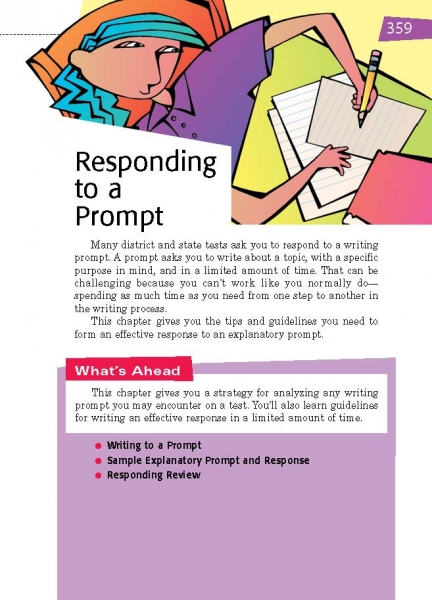Page 359 from

Start-Up Activity
Provide your students with the following prompt. Challenge them to identify the key parts: purpose, audience, subject, and type (see the questions below).
John Lennon once observed, “Life is what happens to you while you are busy making other plans.” If that is true, is it better to live life without a plan, to carefully follow a precise plan, or to somehow balance planning and spontaneity (sudden inspiration)? Write a letter to the editor of your school newspaper, arguing for how a person should plan (or not plan) life. Support your claim using examples from your life and the lives of other students.
- Purpose: Why is the goal of the response?
- Audience: Who is the intended audience for the response?
- Subject: What are you supposed to write about?
- Type: What form should the writing take?
Discuss their answers. Then note that the purpose of this chapter is to help students understand and respond to timed writing prompts.
Think About It
“They always say time changes things, but you actually have to change them yourself.”
―Andy Warhol

Start-Up Activity
Provide your students with the following prompt. Challenge them to identify the key parts: purpose, audience, subject, and type (see the questions below).
John Lennon once observed, “Life is what happens to you while you are busy making other plans.” If that is true, is it better to live life without a plan, to carefully follow a precise plan, or to somehow balance planning and spontaneity (sudden inspiration)? Write a letter to the editor of your school newspaper, arguing for how a person should plan (or not plan) life. Support your claim using examples from your life and the lives of other students.
- Purpose: Why is the goal of the response?
- Audience: Who is the intended audience for the response?
- Subject: What are you supposed to write about?
- Type: What form should the writing take?
Discuss their answers. Then note that the purpose of this chapter is to help students understand and respond to timed writing prompts.
Think About It
“They always say time changes things, but you actually have to change them yourself.”
―Andy Warhol

